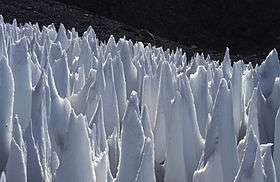Penitente (snow formation)

Penitentes, or nieves penitentes (Spanish for "penitent-shaped snows"), are snow formations found at high altitudes. They take the form of elongated, thin blades of hardened snow or ice, closely spaced and pointing towards the general direction of the sun.[1]
The name comes from the resemblance of a field of penitentes to a crowd of kneeling people doing penance. The formation evokes the tall, pointed habits and hoods worn by brothers of religious orders in the Processions of Penance during Spanish Holy Week. In particular the brothers' hats are tall, narrow, and white, with a pointed top.
These spires of snow and ice grow over all glaciated and snow-covered areas in the Dry Andes above 4,000 metres or 13,120 feet.[2][3][4] They range in length from a few centimetres to over 5 metres or 16 feet.[4][5]
First description
Penitentes were first described in scientific literature by Charles Darwin in 1839.[6] On March 22, 1835, he had to squeeze his way through snowfields covered in penitentes near the Piuquenes Pass, on the way from Santiago de Chile to the Argentine city of Mendoza, and reported the local belief (continuing to the present day) that they were formed by the strong winds of the Andes.
Formation
Louis Lliboutry noted that the key climatic condition behind the differential ablation that leads to the formation of penitentes is a dew point that remains below freezing. This combined with dry air will cause snow to sublimate. Once the process of differential ablation starts, the surface geometry of the evolving penitente produces a positive feedback mechanism, and radiation is trapped by multiple reflections between the walls. The hollows become almost a black body for radiation, while decreased wind leads to air saturation, increasing dew point temperature and the onset of melting. In this way peaks, where mass loss is due to sublimation alone, will remain, as well as the steep walls, which intercept only a minimum of solar radiation. In the troughs, the ablation is enhanced, leading to a downward growth of penitentes. A mathematical model of the process has been developed by Betterton,[7] although the physical processes at the initial stage of penitente growth, from granular snow to micropenitentes, still remain unclear. The effect of penitentes on the energy balance of the snow surface, and therefore their effect on snow melt and water resources has also been studied.[8][9]
Non-terrestrial
Penitentes up to 15m (50ft) high are suggested to be present in the tropics zone on Europa, a satellite of Jupiter.[10][11] According to a recent study, NASA's New Horizons has discovered penitentes on Pluto,[12] in a region informally named Tartarus Dorsa.[13][14]
Gallery

- Small penitentes in the summit crater of Mount Rainier.
 Penitentes ice formations at the southern end of the Chajnantor plain in Chile.
Penitentes ice formations at the southern end of the Chajnantor plain in Chile.- Penitentes near the summit of the Agua Negra Pass on the border between Chile and Argentina.
See also
References
- ↑ "Planetary Analogue". Archived from the original on 4 March 2016. Retrieved 8 June 2015.
- ↑ Lliboutry, L. (1954a). "Le Massif du Nevado Juncal ses penitentes et ses glaciers". Revue de Géographie Alpine. 42: 465–495. doi:10.3406/rga.1954.1142.
- ↑ Lliboutry, L. (1954b). "The origin of penitentes". Journal of Glaciology. 2: 331–338.
- 1 2 Lliboutry, L. (1965). Traité de Glaciologie, Vol. I & II (in French). Paris, France: Masson.
- ↑ Naruse, R.; Lieva, J.C. (1997). "Preliminary study on the shape of snow penitents at Piloto Glacier, the Central Andes". Bulletin of Glacier Research. 15: 99–104.
- ↑ Darwin, C. (1839). Journal of researches into the geology and natural history of the various countries visited by H. M. S. Beagle, under the command of Captain Fitz Roy, R.N., 1832 to 1836. London, UK: H. Colburn.
- ↑ Betterton, M.D. (2001). "Theory of structure formation in snowfields motivated by penitentes, suncups, and dirt cones". Physical Review E. 63: 12. doi:10.1103/physreve.63.056129.
- ↑ Corripio, J.G. (2003). Modelling the energy balance of high altitude glacierised basins in the Central Andes (PDF) (PhD. thesis). Edinburgh, UK: University of Edinburgh. p. 151. Archived (PDF) from the original on 13 November 2013. Retrieved 7 September 2013.
- ↑ Corripio, J.G.; Purves, R.S. (2005). "Surface Energy Balance of High Altitude Glaciers in the Central Andes: the Effect of Snow Penitentes". In de Jong, C.; Collins, D.; Ranzi, R. Climate and Hydrology in Mountain Areas (PDF). London, UK: Wiley & Sons. p. 18. Retrieved 7 September 2013.
- ↑ https://www.nbcnews.com/mach/science/jupiter-moon-may-have-huge-jagged-ice-blades-complicate-search-ncna918156
- ↑ "Archived copy". Archived from the original on 2013-12-22. Retrieved 2017-09-28.
- ↑ "Icy ridges only before seen on Earth are found on Pluto". Mail Online. Archived from the original on 2017-01-05. Retrieved 2017-01-05.
- ↑ Talbert, Tricia (2017-01-04). "Scientists Offer Sharper Insight into Pluto's Bladed Terrain". NASA. Archived from the original on 2017-01-05. Retrieved 2017-01-05.
- ↑ Moores, John E.; Smith, Christina L.; Toigo, Anthony D.; Guzewich, Scott D. (2017-01-12). "Penitentes as the origin of the bladed terrain of Tartarus Dorsa on Pluto". Nature. 541 (7636): 188–190. doi:10.1038/nature20779. Retrieved 13 January 2017.
Further reading
- Bergeron, Vance; Berger, Charles; Betterton, M. D. (2006). "Controlled Irradiative Formation of Penitentes". Physical Review Letters (PRL). 96 (098502). arXiv:physics/0601184v1.
- Kotlyakov, V. M.; Lebedeva, I. M. (1974). "Nieve and ice penitentes, their way of formation and indicative significance". Zeitschrift für Gletscherkunde und Glazialgeologie [Journal of Glacial Science and Glacial Geology] (in German). X: 111–127.
Describes appearance and formation of these ablation features, with reference to those observed in eastern Pamir, U.S.S.K.
- Lliboutry, L. (1998). "Glaciers of the Dry Andes". In Williams, R. S. J.; Ferrigno, J. G. Satellite Image Atlas of Glaciers of the World. South America, United States Geological Survey Professional Paper. USGS-p1386i.
External links

- "Spiky glaciers are slower to melt", New Scientist (March 7, 2007).